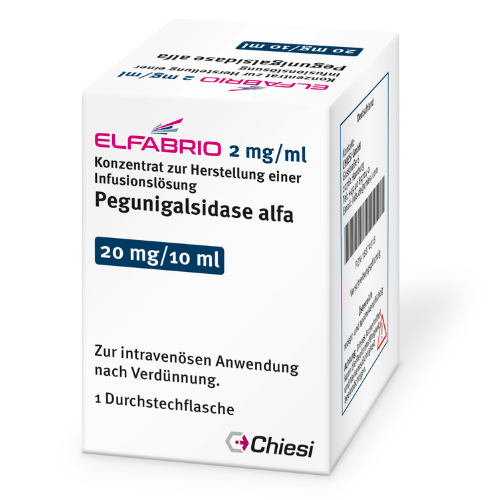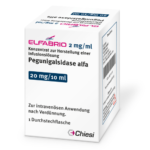About Elfabrio
- Elfabrio, a pegylated enzyme replacement therapy (Pegunigalsidase alfa-iwxj), offers treatment for confirmed Fabry disease in adults. It is a hydrolytic lysosomal neutral glycosphingolipid-specific enzyme.
- The US FDA administration granted approval to the drug on May 9, 2023.
- Fabry disease, an inherited X-linked disorder, results from alpha-galactosidase-A enzyme deficiency. This deficiency leads to the buildup of globotriaosylceramide (Gb3) in blood vessels and tissues, elevating the risk of heart attacks, strokes, and kidney failure.
- Symptoms include numbness, severe pain during physical activity, temperature sensitivity, dizziness, and flu-like symptoms, with males often experiencing more severe effects.
- Elfabrio effectively replaces the missing alpha-galactosidase A enzyme, facilitating Gb3 breakdown and preventing its accumulation.
- Before starting the treatment inform the healthcare provider with all the pre-existing health conditions.
Strength:
Injection: The injection is available in single-dose vials, each containing a 20 mg/10 mL (2 mg/mL) solution.
Recommended Dosage:
For ERT-experienced patients, consider using antihistamines, antipyretics, and/or corticosteroids as pretreatment before the initial Elfabrio infusions. After 4 to 6 infusions, the pretreatment medication dose(s) can be gradually reduced or discontinued if Elfabrio is well-tolerated.
In patients new to ERT, prior to Elfabrio administration, consider pre-treatment with antihistamines, antipyretics, and/or corticosteroids. Ensure the availability of appropriate medical support measures, including cardiopulmonary resuscitation equipment, during Elfabrio administration.
- Elfabrio’s recommended dosage, based on actual body weight, is 1 mg/kg via intravenous infusion every two weeks.
- The initial infusion rates are determined according to body weight.
- If a dose is missed, restart treatment as soon as possible while maintaining the two-week interval between infusions. Do not double the dose to compensate for a missed one.
- For mild to moderate hypersensitivity reactions or mild to moderate infusion-related reactions, contemplate a temporary pause in the infusion for 15 to 30 minutes or a reduction in the infusion rate by 25% to 50%.
Important
Maintain aseptic practices during preparation by calculating the necessary Elfabrio vials based on the patient’s actual body weight and rounding up to the nearest whole number. Allow the vials to reach room temperature for 15-30 minutes, inspect for clarity and colorlessness, and discard any discolored or particulate solutions.
Dilute the Elfabrio solution in 0.9% Sodium Chloride Injection according to the patient’s weight. Before adding Elfabrio, remove an equal volume of 0.9% Sodium Chloride Injection from the infusion bag. Withdraw the required Elfabrio volume from the vials, injecting it into the infusion bag through the port, and gently invert the bag to mix the solution, avoiding vigorous shaking or agitation.
Warnings & Precautions
- Elfabrio carries important warnings and precautions. It has been associated with hypersensitivity reactions, including anaphylaxis, which were reported in clinical trials.
- For severe hypersensitivity reactions or infusion-related reactions (e.g., anaphylaxis), promptly cease Elfabrio administration and seek immediate medical attention.
- Patients with pre-existing antibodies are at an increased risk.
- Mild to moderate hypersensitivity reactions may lead to temporary suspension or slowed infusion.
- Elfabrio is also linked to infusion-associated reactions (IARs), affecting almost 30% of patients in clinical trials. These reactions include anaphylaxis, nausea, and other symptoms.
- Pre-treatment with antihistamines, antipyretics, and corticosteroids may be considered to mitigate risks.
- In cases of severe IARs, discontinuation and appropriate treatment are recommended. Patients with advanced Fabry disease and compromised cardiac function should be closely monitored, and any suspicion of membranoproliferative glomerulonephritis should lead to discontinuation and diagnostic evaluation. Monitoring of serum creatinine and urinary protein is essential in such cases.
Common Elfabrio Side Effects:
- Back pain
- Bloody or cloudy urine
- Burning, numbness, tingling, or painful sensations
- Chest tightness
- Chills
- Cough
- Ear congestion
- Fast heartbeat
- Fever
- Flushing
- Headache
- Loss of voice
- Muscle aches
- Nausea and vomiting
- Nerve pain
- Pain in the arms, legs, lower back, bottom, or hips
- Skin itching, rash, or redness
- Sneezing
- Sore throat
- Stuffy or runny nose
- Swelling of the face, throat, or tongue
- Trouble breathing
- Trouble swallowing
- Unsteadiness or awkwardness
- Unusual tiredness or weakness
- Weakness in the arms, hands, legs, or feet
Use in Specific Population
- Elfabrio lacks data on its use during pregnancy for assessing potential risks like major birth defects or miscarriage. However, being an enzyme replacement therapy, it is not anticipated to cause adverse effects.
- Animal studies on pregnant rats showed no adverse effects on fetal development at doses up to 3.6 times the recommended human dose. In pregnant rabbits, there was maternal toxicity at doses over 3.2 times the recommended dose.
- No data are available regarding the presence of Pegunigalsidase alfa-iwxj in human or animal milk, its effects on the breastfed infant, or milk production.
- Elfabrio’s safety and effectiveness have not been established in pediatric patients.
- Clinical trials of Elfabrio did not include patients aged 65 and older to determine any age-related differences in response.
- Patients switching from other enzyme replacement therapies (ERT) to Elfabrio, especially those with pre-existing anti-drug antibodies (ADA), may experience reduced Elfabrio efficacy and an increased risk of hypersensitivity and infusion-associated reactions. Monitoring clinical or pharmacodynamic responses is advisable when switching from agalsidase beta to Elfabrio in patients with pre-existing ADA.
Storage and Handling
- Store Xacduro vial refrigerated at 2°C – 8°C (36°F – 46°F) in the original carton.
- Protect the medicine from light. Do not freeze. Do not shake.
- After dilution, you can refrigerate the Elfabrio solution at 2°C to 8°C for up to 24 hours or store it at room temperature (20°C to 25°C) for 8 hours. The solution must be infused within 8 hours, inclusive of infusion time, or discarded. Do not freeze or shake.
- Xacduro is a sterile product, and it should not be used if the vial is damaged or the seal is broken.
Sansfro ensures that patients can obtain the prescription medications they require by adhering to a straightforward four-step protocol for medication procurement:
- Medication Inquiry: Within 24 hours of receiving a patient’s inquiry, the Sansfro Named Access Programme Support team processes the patient’s information and gets in touch to offer assistance.
- Verification Process: Sansfro makes sure that the availability and approval of medications are verified in order to assist patients in obtaining medications that might not be permitted or easily accessible in their home countries. In order to ensure accuracy and compliance, they also carefully go over the patient’s prescription and medical records.
- Medication Procurement: Sansfro’s staff gets in touch with their network of suppliers to acquire the necessary medication as soon as the patient passes the verification process. They keep an eye on the order processing and put in a lot of effort to get the medications at reasonable costs.
- Safe Delivery: Sansfro arranges for the consignment’s safe delivery after the final quote is accepted. Sansfro’s team of logistics specialists offers assistance with tracking shipments, and they strictly follow SOPs to guarantee the safe and authorised distribution of medications.
The Sansfro team will begin by requiring the following documentation from patients in order to import medication:
- A legitimate prescription copy.
- A record attesting to their identity.
- Details regarding the physician who wrote the prescription.
- Current address at home.
Following receipt of these documents, the Sansfro team will get to work on submitting the import licence application. Once the government has approved the request, this licence is an essential requirement to obtain the necessary medication.
No news found.
About Sansfro
Sansfro is committed to bridging the healthcare gap. Our purpose is to bring hope and healing to patients suffering from rare diseases by linking them with life-saving treatments through our Named Patient Program. Join us in our quest for a better and healthier world.
Know More...FAQ'S
How does Elfabrio work?
Elfabrio operates as an enzyme replacement therapy (ERT), addressing the deficiency of the alpha-galactosidase A enzyme in individuals with Fabry disease. This enzyme is responsible for breaking down a fatty substance known as globotriaosylceramide (Gb3) within the body.
What type of filter should be used during Elfabrio administration?
It’s recommended to use an in-line low protein-binding, 0.2-micron filter during administration.
Is it possible to modify the duration of Pegunigalsidase alfa-iwxj infusions for future administrations?
Yes, if a patient tolerates the initial 4-6 Elfabrio infusions, the duration of every third infusion may be decreased in decrements of 30 minutes as tolerated, with a minimum recommended infusion duration of 1.5 hours.
Did Pegunigalsidase alfa-iwxj injection have any impact on fertility in adult rats during studies?
In studies, no adverse effects on fertility were observed when Pegunigalsidase alfa-iwxj injection was administered to adult rats at exposures that were up to 3.6-fold greater than the recommended dose of 1 mg/kg every two weeks.
What is the difference between Elfabrio and Pegunigalsidase alfa-iwxj
Elfabrio and Pegunigalsidase alfa-iwxj represent different designations for the identical medication. Specifically, Elfabrio serves as a brand name for Pegunigalsidase alfa-iwxj, which functions as an enzyme replacement therapy designed to address Fabry disease. While the names may diverge based on location or manufacturer, the medication’s fundamental composition and intended purpose are consistent.
What are the common adverse reactions to Elfabrio?
The most frequently reported adverse reactions (with an incidence of 15% or higher) during Elfabrio treatment include infusion-associated reactions, nasopharyngitis, headache, diarrhea, fatigue, nausea, back pain, pain in extremities, and sinusitis
What is the Elfabrio price in India and how to buy Elfabrio Online?
As Elfabrio is not available in India, the pricing of Elfabrio depends on various factors such as the cost of the medicine, shipping, custom clearance, and documentation. If you wish to buy Elfabrio online, kindly reach out to our Patient Support Team at (+91) 93157 05373 or via email at help@sansfro.com.

Dr Anchal Aryan
Medical counselor
Patient Stories
Word Wide Delivery:
India, Andorra, Argentina, Australia, Austria, Azerbaijan, Bahrain, Brazil, Bulgaria, Cambodia, Canada, Chile, Colombia, Costa Rica, Croatia, Cyprus, Denmark, Dominican Republic, Estonia, Finland, France, Georgia, Germany, Ghana, Greece, Guatemala, Iraq, Ireland, Israel, Italy, Jamaica, Japan, Jordan, Kenya, Kuwait, Latvia, Lebanon, Libya, Lithuania, Malawi, Mexico, Montenegro, Nepal, Netherlands, New Zealand, Nigeria, Norway, Oman, Pakistan, Paraguay, Peru, Poland, Qatar, Romania, Saudi Arabia, Serbia, Singapore, Slovenia, Spain, Sri Lanka, Sweden, Switzerland, United Arab Emirates, United Kingdom, United States, Venezuela, Zimbabwe, Afghanistan, Albania, Algeria, American Samoa, Angola, Anguilla, Antarctica, etc.



